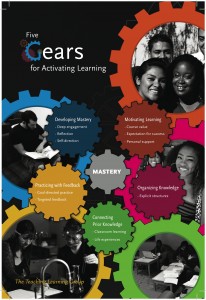By Cynthia Desrochers, California State University Northridge
Lately, two contradictory adages have kept me up nights: “K.I.S.S. – Keep It Simple, Stupid” (U.S. Navy) and “For every complex problem there is an answer that is clear, simple, and wrong” (H.L. Mencken). Which is it? Experts have a wealth of well-organized, conditionalized, and easily retrievable knowledge in their fields (Bradford, et al., 2000). This may result in experts skipping over steps when they teach a skill that has become automatic to them. But where does this practice leave our novice learners who need to be taught each small step—almost in slow motion—to begin to grasp a new skill?
I have just completed co-facilitating five of ten scheduled faculty learning community (FLC) seminars in a yearlong Five GEARS for Activating Learning FLC. As a result of this experience, my takeaway note to self now reads in BOLD caps: (1) keep it simple in the early stages of learning and (2) model the entire process and share my thinking out loud—no secrets hidden behind the curtains!
The Backstory
The Five Gears for Activating Learning project at California State University, Northridge, began in fall 2012. It was my idea, and I asked seven university-wide faculty leaders to join me in a grassroots effort. Our goals were to improve student learning from inside the classroom (vs. policy modifications), promote faculty use of the current research on learning, provide a lens for judging the efficacy of various teaching strategies (e.g., the flipped classroom), and develop a common vocabulary for use campuswide (e.g., personnel communications). Support for this project came from the University Provost and the dean of the Michael D. Eisner College of Education in the form of reassigned time for me and 3-unit buyouts for each of the eight FLC members, spread over the entire academic year, 2014-15.
We read as a focus book How Learning Works: 7 Research-Based Principles for Smart Teaching (Ambrose, et al., 2010). We condensed Ambrose’s seven principles to five GEARS, one of which is Developing Mastery, which we defined as deep learning, reflection, and self-direction—critical elements of metacognition and the focus of this blog site.
On Keeping It Simple
I have been in education for forty-five years, yet I’m having many light-bulb moments with this FLC group – I’m learning something new, or reorganizing prior knowledge, or having increased clarity. Hence, I’ve given a lot of thought to the conflict between keeping it simple and omitting some important elements versus sharing more complex definitions and relationships and overwhelming our FLC members. My rationale for choosing simple: If I am still learning about how learning works, how can I expect new faculty—who teach Political Science, Business Law, Research Applications, and African Americans in Film, all without benefit of a teaching credential—to process some eighty years of research on learning in two semesters?
In opting for the K.I.S.S. approach, we have developed a number of activities and tools that scaffold learning to use the five GEARS in our teaching; moreover, each activity or tool models explicitly with faculty some practices we are encouraging them to use with their students. This includes (1) reflective writing in the form of learning logs and diaries, (2) an appraisal instrument to self-assess their revised (using the GEARS) spring 2015 course design, and (3) a class-session plan to scaffold their use of the GEARS. [See the detailed descriptions given in the handout resource posted on this site.] I hope to have some results data regarding their use in my spring blog.
Looking to next semester, our spring FLC projects will likely center around not only teaching the redesigned five GEARS course but also disseminating the five GEARS campuswide. As a direct result of the Daily Diary that FLC members kept for three weeks on others’ use and misuse of the five GEARS, they want to share our work. [See handout for further description of the Daily Diaries.] Dissemination possibilities include campus student tour guides, colleagues who teach a common course, Freshman Seminar instructors, librarians, and the Career Center personnel. If another adage is true, “Tell me and I forget, teach me and I may remember, involve me and I learn” (Benjamin Franklin), our FLC faculty will likely move of their own accord along the continuum from a simple to complex understanding of the five GEARS in their efforts to teach the five GEARS to others on campus.
A Word about GEARS
Why is this blog not focusing solely on the metacognition gear, which we call Developing Mastery? The simple answer is that learning is so intertwined that all the GEARS likely support metacognition in some way. However, any one of the activities or tools we have employed can be modified to limit the scope to your definition of metacognition. Our postcard below shows all five GEARS:
